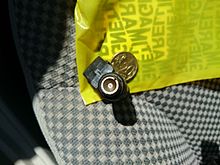Injector
An injection valve is a valve which in a combustion engine fuel in the intake system or the combustion chamber is injected.
In gasoline engines nowadays predominantly electrically controlled come solenoid valves are used. Mechanical injectors as they are z. B. Bosch K-Jetronic existed until the 1990s, are no longer suitable for modern, electronic injection systems. In the case of diesel engines, valves that react hydraulically to pressure have historically been used, while electrically controlled valves are used in the pump-nozzle system and common-rail injection . In addition to solenoid valves, piezoelectric valves are also used in direct injection .
In the case of direct injection, the fuel is sometimes distributed over up to ten injections. In the case of diesel engines, a pre-injection is common, which improves the running smoothness and the exhaust system can be heated up with late post-injections.
The decisive factor in diesel injection is the spray pattern, i.e. how the nozzle distributes the fuel during the injection. A distinction is made here between air-distributed fuel and wall-distributed fuel (MAN M process).
Nozzle failure
In the ideal state of airborne fuel, the injection jet should contain fine droplets on the outside and atomize into larger droplets in the center. As a result, the finer droplets ignite first, the fuel burns more slowly and more evenly and there is a comparatively gentle pressure increase in the combustion chamber.
The main flaw in injection is poor atomization, which can affect in several ways:
- Knocking combustion : a large part of the amount of fuel injected burns suddenly. This is noticeable acoustically through the well-known “nailing” of the diesel engine (a form of knocking combustion), which can usually lead to increased consumption, loss of power, poor exhaust quality and, in the long term, damage to the engine's plain bearings.
- Local overheating : If the jet direction is misaligned and the fuel-air mixture is aimed at components, these can burn through (e.g. a hole in the piston crown).
- Tear off the lubricating film : if the fuel jet is aimed at the cylinder wall, the lubricating film can be washed off. Because of the lower lubricating effect of the fuel, seizure damage is to be expected.
Other faults include a leaking nozzle or broken nozzle springs (with classic nozzles that only act as a throttle), so that fuel continues to run into the combustion chamber before or after regular injection. The fuel film cokes on the nozzle and in turn prevents correct atomization.
literature
- Hans Jörg Leyhausen: The master craftsman examination in the automotive trade part 1 . 12 edition, Vogel Buchverlag, Würzburg, 1991, ISBN 3-8023-0857-3
- Max Bohner, Richard Fischer, Rolf Gscheidle: Expertise in automotive technology. 27th edition, Verlag Europa-Lehrmittel, Haan-Gruiten, 2001, ISBN 3-8085-2067-1
Individual evidence
- ↑ From the injector to injector 2. Accessed February 26, 2020 .



